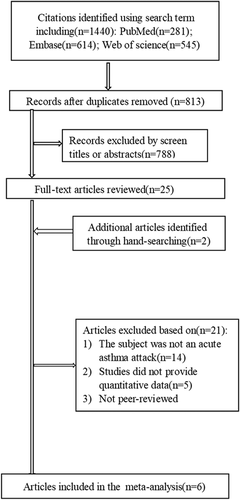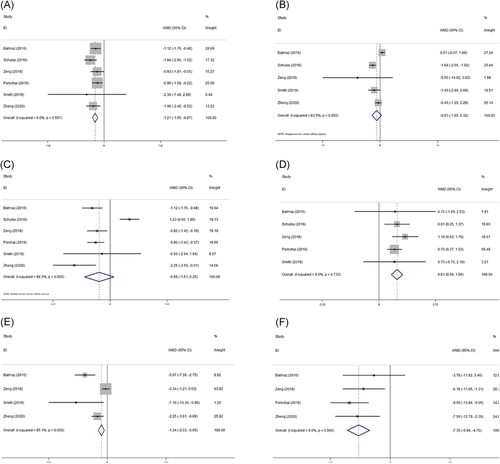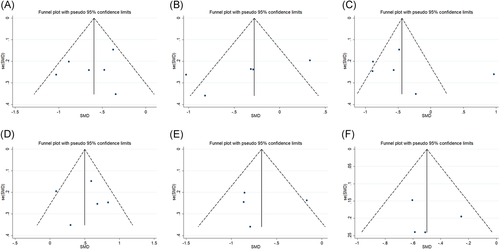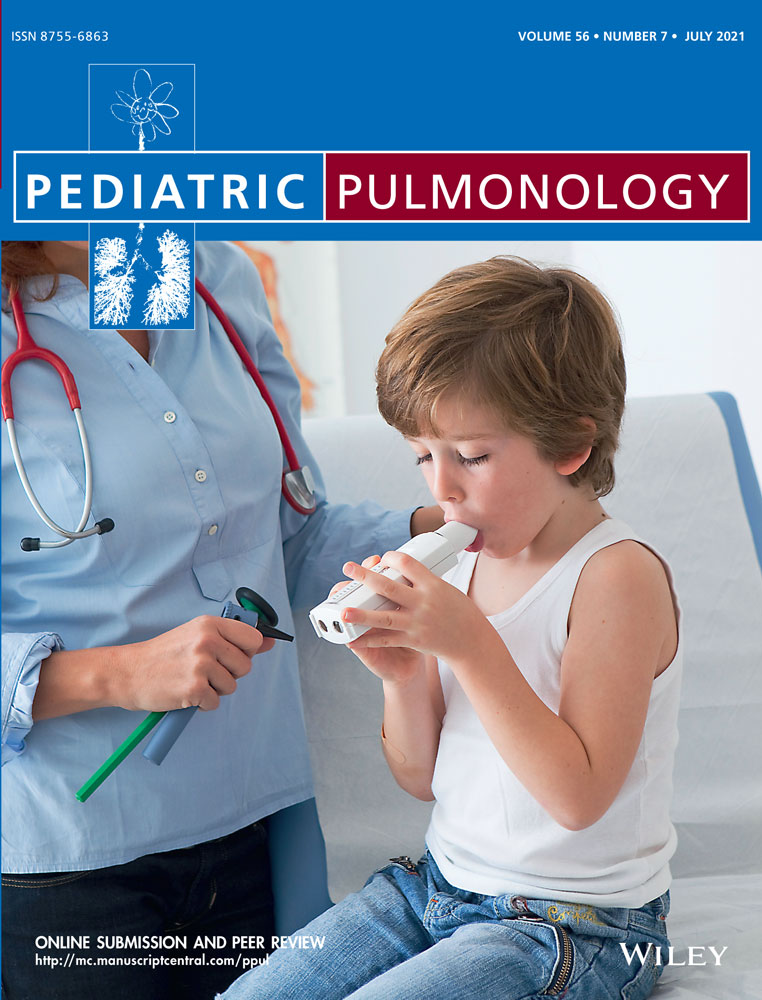The predictive value of impulse oscillometry for asthma exacerbations in childhood: A systematic review and meta-analyses
Yaoyao Ling and Minghui Si contributed equally to this study.
Abstract
Objective
Several studies have explored the predictive value of impulse oscillometry (IOS) for asthma exacerbations in childhood, but its specific parameters are still unclear. Therefore, we designed this meta-analysis to determine the related indicators of acute asthma attacks.
Methods
A comprehensive literature search was performed on July 9, 2020 based on PubMed, Embase, and Web of Science database. Weighted mean differences (WMDs) were calculated using fixed- or random-effects models.
Results
A total of 615 patients from six trials were included in this analysis. IOS may be a useful tool to predict asthma exacerbations. And the results showed that R5 (WMD = −1.21, 95% CI: −1.55 to −0.87, p < .001), Fres (WMD = −1.34, 95% CI: −2.03 to −0.65, p = .018), and AX (WMD = −7.35, 95% CI: −9.94 to −4.76, p < .001) had significant correlation with asthma exacerbations. In addition, X5 may also predict the acute attack of asthma (WMD = 0.81, 95% CI: 0.56 to 1.01, p < .001).
Conclusions
R5, AX, Fres, and X5 may be able to identify the risk of an acute attack of asthma. Besides, our research further demonstrated that peripheral airway injury may play an important role in the acute attack of asthma.
1 INTRODUCTION
Asthma is the most common chronic lower respiratory disease in childhood. Acute exacerbation of asthma is one of the main causes of emergency department visits and may lead to long-term pulmonary impairment in children.1-3 Lung function tests are a common detection method of asthma. Longitudinal monitoring of respiratory parameters is helpful to early intervention and improve prognosis.
Spirometry has traditionally been employed to evaluate lung function, considered as the gold standard.4 However, young children may be unable to perform the test, since it requires effort-dependent lung maneuvers. The effort-dependent nature of the test interferes with the reproducibility of the test. Besides, spirometry may be limited when clinical conditions do not allow it to be carried out safely.5
For these reasons, impulse oscillometry (IOS), based on forced oscillation technique (FOT), has been noticed to measure lung function in young children (mainly over 3 years old).6 Compared with spirometry, IOS is a much simpler and noninvasive technique for assessing airway impedance and responsiveness in children. It is effort-independent that can be performed in tidal breathing and requires minimal patient cooperation. Also, it can distinguish between the degree of obstruction in central and peripheral airways.7, 8 The main indicators of IOS are R5 (resistance at 5 Hz), R20 (resistance at 20 Hz), R5−20 (resistance at 5 Hz minus resistance at 20 Hz), X5 (reactance at 5 Hz), AX (reactance area), and Fres (resonant frequency of reactance). Because low oscillation frequencies can transmit more distally in the lungs than high frequencies, R5 reflects the respiratory system resistance while R20 reflects the central airways resistance. R5−20, an indicator of frequency dependence of the resistance, is an index of the peripheral airways. X5, the reactance of the respiratory system at 5 Hz, represents the peripheral elastic resistance. AX reflects the elastic properties of the lung. As with low-frequency reactance, it provides important information about small airway obstruction. Fres, the oscillation frequency when the reactance is zero, which can distinguish between low-frequency reactance and high-frequency reactance.
In recent years, many studies have explored the predictive value of IOS for asthma exacerbations in childhood, but the role of IOS in predicting exacerbations is not clear as well as the parameters of the IOS measurements related to this outcome. Therefore, we performed a systematic literature review and meta-analysis to further investigate the issue and identify potential sources of heterogeneity that might be confounders that have affected some existing conclusions.
2 METHODS
This meta-analysis strictly followed the recommendations of the Preferred Reporting Items for Systematic Reviews and Meta-Analyses Statement.9 No ethical approval and patient consent were required for this review as all data were already published in peer-reviewed journals.
2.1 Literature search and selection criteria
We conducted a comprehensive literature search of the PubMed, Embase, and Web of Science databases up to July 9, 2020, with the following search algorithm: (asthma or asthmas or bronchial asthma or asthma, bronchial) and (IOS or forced oscillatory impedance). Besides, the reference lists of retrieved articles and related reviews were examined to identify any potential relevant research. There were no language or publication date restrictions. The flow diagram was presented in Figure 1.

The inclusion criteria were as follows: (1) the study was designed as a case–control, cross-sectional, or retrospective cohort study; (2) participants were children (≤14 years old) with asthma exacerbations or poorly controlled asthma, which was diagnosed according to the Global Initiative for Asthma or relevant guidelines; (3) participants used IOS to evaluate lung function; (4) outcome measures included IOS parameters.
To ensure accuracy, two authors chose the studies independently, resolved their differences through discussion with the third author, and selected the articles to be included by consensus.
2.2 Quality assessment and data extraction
The Newcastle–Ottawa Scale (NOS) was applied to assess the quality of included studies by two independent authors. NOS is a 9-star system, which scores observational studies on three dimensions: selection (4 items), comparability (1 item), and exposure/outcome (3 items). Except for comparability (2 points), 1 point will be given for each item. A score of ≥7 was considered a high-quality article.
Two authors independently abstracted data and any discrepancy was resolved by consensus. The following variables were collected from each study: author, publication year, country, type of study, age of baseline, sample size and number of cases, and measurements. The outcome of interest was parameters of IOS that can predict asthma exacerbations or loss of control.
2.3 Statistical analyses
For studies that reported separate effect size estimates of different related indicators of IOS in acute asthma attacks, we combined these risk estimates into each study, weighted by the inverse of the variance. Subgroup analyses were performed based on different parameters of IOS related to asthma exacerbations. Heterogeneity across included studies was assessed with the Cochrane Q test (the level of significance was set at 0.1).10 The I 2 score was also used to determine the degree of heterogeneity (I 2 < 50%, no obvious heterogeneity; I 2 > 50%, large or extreme heterogeneity).11 Galbraith plot12 was introduced to identify the studies that contributed to the heterogeneity and meta-analysis was performed again after removing these studies.
In the sensitivity analysis, the meta-analysis was repeated after each study was omitted. Begg's test13 and Egger's test14 were used to assess publication bias. Meta-analysis was conducted using STATA 12.0.
3 RESULTS
3.1 Study selection
A total of 1440 records were acquired from the three electronic databases. After removing duplicate records, the titles and/or abstracts were independently reviewed by the two authors to assess their eligibility based on the inclusion criteria. Two more articles were added by hand-searching, so all 27 records were searched in full-text, and 21 records were eliminated due to the following reasons: (1) the subject was not an acute asthma attack; (2) studies did not provide quantitative data; (3) not peer-reviewed (Figure 1).
3.2 Characteristics of the included studies
A total of six eligible studies,15-20 including four case–control articles, one retrospective cohort study and one cross-sectional article published between 2016 and 2020, were enrolled in the present meta-analysis. The studies were conducted in the following geographical regions: United States (n = 2), Germany (n = 1), Turkey (n = 1), and China (n = 2). All studies used well-controlled asthma as the control group, and four studies also added healthy people as the control group.15, 17, 18, 20 Our study focused on the role of IOS in predicting asthma exacerbations or loss of control, so we did not include healthy people. The sample size ranged from 54 to 192, including 615 children with an average age of 3.65–11.20 years. All participants performed IOS. The procedures of IOS in all the included studies were followed in accordance with the published guidelines. Meaningful pulse oscillation parameters varied among the trials. The quality scores of these studies were evaluated by the NOS ranging from 7 to 8. The characteristics of all studies were summarized in Table 1.
| Study | Year | Country | Type of study | Age of baseline | Sample | Devices | Outcome measures | |
|---|---|---|---|---|---|---|---|---|
| Cases | Controls | |||||||
| Batmaz et al.15 | 2016 | Turkey | Case–control | 10.69 | 35 | 107 | MasterScreen IOS (Jaeger Co.) | X5, R5, R20, R5–R20, AX, Fres |
| Zeng et al.17 | 2018 | China | Case–control | 3.65 | 52 | 27 | IOS (Jaeger Co.) | X5, R5, R20, R5–R20, AX, Fres |
| Smith et al.19 | 2020 | United States | Case–control | 11.20 | 44 | 10 | IOS (BD CareFusion, Vmax Encore system) | X5, R5, R20, R5–R20, Fres |
| Zheng et al.20 | 2020 | China | Case–control | 3.79 | 51 | 28 | IOS (Jaeger Co.) | R5, R20, R5–R20, AX |
| Schulze et al.16 | 2016 | Germany | Cross-sectional | 5.00 | 42 | 27 | MasterScreen IOS (CareFusion) | X5, R5, R5−R20 |
| Tirakitsoontorn et al.18 | 2018 | United States | Retrospective | 9.85 | 96 | 96 | LabManager Version 4.67.0.1 (CareFusion Germany GmbH) | X5, R5, R5–R20, AX |
3.3 Association between pulse oscillation parameters and asthma exacerbations
The included six studies revealed that IOS may be able to identify the risk of acute attack or loss of control of asthma. We further analyzed the value of IOS common parameters in predicting the loss of asthma control. In terms of resistance, we found that elevated levels of R5 may indicate the risk of asthma exacerbations (weighted mean difference [WMD] = −1.21, 95% CI: −1.55 to −0.87, p < .001) (Figure 2A). However, as for R20 (WMD = −0.81, 95% CI: −1.95 to 0.32, p = .161), R5-20 (WMD = −0.68, 95% CI: −1.61 to 0.25, p = .151), the results did not show a good correlation with the acute attack of asthma (Figure 2B,C). In terms of reactance, we found X5 (WMD = 0.81, 95% CI: 0.56 to 1.01, p < .001) were significantly related to the loss of asthma control (Figure 2D). Moreover, the Fres (WMD = −1.34, 95% CI: −2.03 to −0.65, p = .018) and AX (WMD = −7.35, 95% CI: −9.94 to −4.76, p < .001) can also identify the risk of acute attack or loss of control of asthma (Figure 2E,F).

3.4 Sensitivity analysis and publication bias
Sensitivity analysis confirmed that no individual study influenced the overall results. There was no evidence of publication bias in this meta-analysis indicated by Begg's funnel plot and Egger's tests (Figure 3).

4 DISCUSSION
To our knowledge, this is the first systematic review and meta-analysis of IOS parameters to identify the risk of acute attack or loss of control in children with asthma. Our research involved a total of 615 cases from six studies. We selected common IOS parameters and analyzed them. The results showed that R5, X5, AX, and Fres may better predict asthma exacerbations or loss of control.
Asthma is a common disease in pediatrics. The goal of care is to maximize the safety of treatment by achieving and maintaining the control of disease at the lowest level and dose of inhaled corticosteroids (ICSs). Studies have shown that childhood asthma control is closely related to adult asthma control, lung function, and chronic obstructive pulmonary disease (COPD).21 An acute attack of asthma is life-threatening, which refers to the sudden occurrence of symptoms such as wheezing, coughing, shortness of breath, chest tightness, or the acute exacerbation of the original symptoms. Both can cause serious economic burdens. Poor control of asthma may increase the risk of an acute attack, which is also a manifestation of uncontrolled asthma.22-24 Moreover, increasing evidence has shown that small airway function is closely related to asthma control, acute attack.25 Therefore, this meta-analysis included both poorly controlled asthma and acute asthma attack.
Pulmonary ventilation function monitoring is an important means for future risk assessment of asthma, but it has certain limitations. IOS has been widely clinically studied because of its simple operation and its ability to measure the impedance of the respiratory system, which consists of reactance and resistance. Previous trials suggested that IOS may be a reliable noninvasive method to assess asthma control in children.26, 27
Resistance can be conceptualized as the energy required for sound waves to pass through the airways and inflate the lung. R5 represents the respiratory system resistance. The included five trials found that R5 increased in asthma exacerbations.14-17, 19 Only Smith et al.19 did not report the difference in R5 between the two groups.17 Our study showed that R5 had a good correlation with the acute attack of asthma. Besides, Galant et al. held that R5 increased significantly when peripheral airway obstruction occurred.28 The reactance of the respiratory system, expressed in Xrs, consists of the inert and elastic properties of the respiratory system. X5 is defined as the peripheral elastic resistance, providing important information about the peripheral respiratory tract. When small airway obstruction and lung compliance decrease, the negative value will increase significantly.29 Our study found a good correlation between X5 and asthma loss of control. Schulze et al.16 found that X5 represents hyperinflation. Tirakitsoontorn et al.18 also reported X5 may be well suited to identify peripheral airway impairment phenotype in the clinical setting. Galant et al.30 further confirmed that X5 decreased significantly in the uncontrolled asthma group. When the respective magnitudes of inertance and elastance are equal, the elastic contribution exactly equals the inertial contribution. Being in opposite directions they cancel each other out and reactance becomes zero. This point is termed resonant frequency (Fres).31
Moreover, based on the mechanical properties of airways, Fres is the dividing point between large and small airways.28 Our result revealed that Fres had a certain significance in predicting the acute attack of asthma, but there was large heterogeneity (I 2 = 85.1%, p = .000). This may be contributed to the small number of trials and the large age span between the trials. AX means the area under the reactance curve between 5 Hz (X5) and the Fres value, similar to X5, which also can provide information about distal airway obstruction.32 Our research found a significant correlation between AX and acute asthma.
Peripheral airways have much smaller lumina than central (large) airways, and inflammation/edema in the walls of peripheral airways can be expected to have a proportionately larger effect on lumen size than inflammation/edema in larger airways. The above indicators reveal that peripheral airway impairment may be associated with uncontrolled asthma. Besides, previous studies have also reported that peripheral airway impairment is clinically related to asthma exacerbation, uncontrolled asthma, loss of control, and asthma severity.26, 27 However, our study did not find the role of the R5−20 indicator in predicting the loss of asthma control. R5−20 refers to the resistance of the peripheral airways, which was also inconsistent with previous research. This may be related to the age and height of the population included in the study. When the peripheral airway was obstructed, R5 was significantly elevated and R20 was not changed. However, R5 decreased linearly with the growth of height.33
Our meta-analysis had some limits. First, the severity of asthma exacerbations or uncontrolled asthma and baseline treatment varied from study to study, which may affect the results. In addition, other factors like race, age, sex, and height can also bring out the heterogeneity. These indicate that a large number of randomized trials are still needed to confirm the potential relationship between IOS parameters and acute attacks of asthma. Our research also had some advantages. For instance, it is the first systematic review and meta-analysis about the predictive value of the IOS common parameter in asthma exacerbations. And all trials were of high quality.
5 CONCLUSION
Overall, our results suggested that R5, X5, AX, and Fres may be able to predict acute attack or loss of control of asthma, while R20 and R5−20 could not. Besides, our research further demonstrated that peripheral airway injury had a good correlation with asthma exacerbations. It may show that in clinical work, the role of peripheral airway injury should be recognized, and timely identification and intervention should be made to reduce the frequency of acute asthma attacks.
ACKNOWLEDGMENT
The study was supported by grants from the Tianjin Science and Technology Program Project (20JCZXJC00170).
CONFLICT OF INTERESTS
The authors declare that there are no conflict of interests.
AUTHOR CONTRIBUTIONS
Yaoyao Ling: Conceptualization (equal); data curation (equal); formal analysis (equal); writing—original draft (lead); writing—review and editing (lead). Minghui Si: Conceptualization (equal); data curation (equal); writing—review and editing (equal). Yufan Niu: Conceptualization (equal); data curation (equal); resources (equal). Yuqi Han: Conceptualization (equal); data curation (equal); formal analysis (equal). Yongsheng Xu: Funding acquisition (equal); investigation (equal); supervision (equal).
Open Research
DATA AVAILABILITY STATEMENT
Data are derived from public domain resources.




